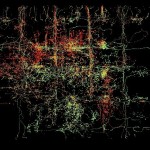Matthew Lewis on Dance and Computer Science
NORAH: For this e-symposium, could you talk a little about your involvement in the project and your interests as a generative designer and computer scientist?

MATT: Sure. As is often the case at ACCAD, many of us served in several roles during different stages of this very interdisciplinary project. Earlier in our process I provided both computer science and generative art and design perspectives as our multidisciplinary team worked to synthesize an understanding of the complex concepts used in Bill’s choreographic approaches in “One Flat Thing, reproduced”. Throughout, I have been able to advise on aspects of our technical development, with respect to both “what is possible and practical” and the inevitable problem solving.
In order to understand and communicate Bill’s concepts and processes (and consider how these could be applied in other fields) we worked to produce qualitative and quantitative data as a step toward investigating Bill’s question, “what else does this look like?” Given the opportunity to explore different ways of visually presenting several aspects of rich source material, I first made use of overhead video of the dance, and then later from the emerging database being constructed to catalog the choreographic events. I tried to reduce complexity by extracting and displaying individual qualities like gestures, paths, and interactions, and then ultimately applied concepts learned from the project to my own generative systems.
I made use of image processing, computer vision, 3D computer graphics, and interactive online algorithms as different ways of exploring the data. My computer science background was also helpful as we tried to systematically formalize the components and parameters of the abstract systems we are representing. I particularly enjoyed participating in discussions between representatives from different disciplines analyzing shifts from centralized control, to bottom-up complex distributed systems. It has also been fascinating for me to consider Bill’s iterative choreographic processes through a lens of optimization concepts like genetic algorithms and fitness landscapes.
In addition to making choreographic concepts more comprehensible to other disciplines, we are very interested in ways in which choreographic knowledge is useful in other contexts. Exposure to such ideas should provide new ways of seeing, communicating, and evaluating relationships among elements in complex dynamic systems. Having not had much exposure previously to contemporary dance, I now have a much greater awareness of its complexity and breadth of conceptual material. It’s intriguing to me that I see much richer relationships between dancers and their movements than I had before being introduced to these concepts.
Our design process made me consider that the choreography of attention, combined with disciplinary knowledge, can control what a viewer perceives. More specifically, it seems that new visual relationship concepts might change what can be seen. I’m still contemplating the relationship between what I think of as more “horizontal” alignments, and the more “vertical” processes of reduction and synthesis. As one might hope for in an academic environment, the project’s framework has emphasized this continuous inquiry, instead of seeking a single correct solution. It also has provided a unique model for collaboration between designers, artists, and scientists that should serve as a valuable benchmark for our projects in the future.
—Matthew Lewis, Advanced Computing Center for the Arts and Design (ACCAD)



Recent Comments